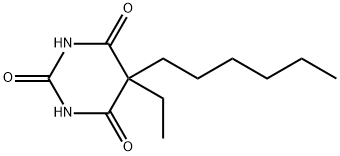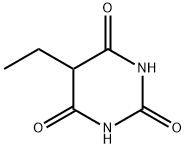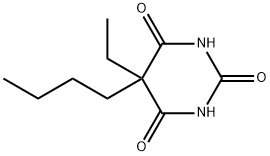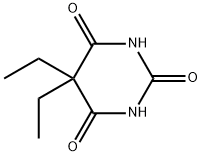CYCLOBARBITAL
- CAS NO.:52-31-3
- Empirical Formula: C12H16N2O3
- Molecular Weight: 236.27
- MDL number: MFCD00059173
- EINECS: 200-138-3
- SAFETY DATA SHEET (SDS)
- Update Date: 2023-05-15 10:44:00

What is CYCLOBARBITAL?
Originator
Cyclobarbital,Bayer
The Uses of CYCLOBARBITAL
Cyclobarbital has been used as an anesthetic and sedative. Controlled substance (depressant).
Definition
ChEBI: Cyclobarbital is a member of barbiturates.
Manufacturing Process
772.0 g of δ-1,2-cyclohexenylcyanacetic acid ethyl ester are introduced into astirred and ice cooled solution of 92.0 g of sodium in 1500 ml of absolutealcohol. The sodium δ-1,2-cyclohexenylcyanacetic acid ester formed is thengradually treated without ice cooling with 750.0 g of ethyl iodide. The reactionmixture become warm, sodium iodide separates out and the whole is neutralafter a short time. The sodium iodide is filtered off, the filtrate freed fromalcohol by distillation, the residues taken up in water, siphoned off, dried overcalcium chloride and distilled in vacuum, yields δ-1,2-cyclohexenylethylcyanacetic acid ethyl ester, boil point 125°C. 72.0 g ofsodium are dissolved in 1086.0 g of absolute alcohol and boiled for 3.75 hwith 285.0 g of guanidine sulfate, then 221.0 g of δ-1,2-cyclohexenylethylcyanacetic acid ester are added and boiling is continued for afurther 12 h. The residue remaining after distilling off the alcohol is boiledwith 10 times its weight of dilute sulfuric acid and then δ-1,2-cyclohexenylethylbarbituric acid which separates out is recrystallized from hotwater, melting point 170°C
brand name
Phanodorn (Sterling Winthrop).
Therapeutic Function
Hypnotic
Safety Profile
Poison by ingestion, subcutaneous, intravenous, and intraperitoneal routes. Human systemic effects by ingestion: pulmonary consolidation. Used as a central nervous system depressant, hypnotic, and sedative. When heated to decomposition it emits toxic fumes of NOx. See also BARBITURATES.
Properties of CYCLOBARBITAL
| Melting point: | 171-174° |
| Boiling point: | 378.73°C (rough estimate) |
| Density | 1.1623 (rough estimate) |
| refractive index | 1.5460 (estimate) |
| solubility | Chloroform (Slightly), Ethanol (Slightly), Methanol (Slightly) |
| pka | 8.03±0.10(Predicted) |
| form | Solid |
| color | White to Off-White |
| Water Solubility | 8.27g/L(25 ºC) |
Safety information for CYCLOBARBITAL
Computed Descriptors for CYCLOBARBITAL
New Products
(S)-3-Aminobutanenitrile hydrochloride 4-Methylphenylacetic acid N-Boc-D-alaninol N-BOC-D/L-ALANINOL Tert-butyl bis(2-chloroethyl)carbamate 3-Morpholino-1-(4-nitrophenyl)-5,6-dihydropyridin- 2(1H)-one Furan-2,5-Dicarboxylic Acid Tropic acid 1-Bromo-3,5-Di-Tert-Butylbenzene S-2-CHLORO PROPIONIC ACID ETHYL ISOCYANOACETATE 2-Bromo-1,3-Bis(Dimethylamino)Trimethinium Hexafluorophosphate 4-IODO BENZOIC ACID 3-NITRO-2-METHYL ANILINE 1-(2,4-DICHLOROPHENYL) ETHANAMINE (2-Hydroxyphenyl)acetonitrile 4-Bromopyrazole 2-(Cyanocyclohexyl)acetic acid 4-methoxy-3,5-dinitropyridine 1-(4-(aminomethyl)benzyl)urea hydrochloride 2-aminopropyl benzoate hydrochloride diethyl 2-(2-((tertbutoxycarbonyl)amino) ethyl)malonate tert-butyl 4- (ureidomethyl)benzylcarbamate Ethyl-2-chloro((4-methoxyphenyl)hydrazono)acetateRelated products of tetrahydrofuran








You may like
-
 2033-24-1 98%View Details
2033-24-1 98%View Details
2033-24-1 -
 42831-50-5 5-METHYLISOXAZOLE-4-CARBOXYLIC ACID 98%View Details
42831-50-5 5-METHYLISOXAZOLE-4-CARBOXYLIC ACID 98%View Details
42831-50-5 -
 1975-50-4 98%View Details
1975-50-4 98%View Details
1975-50-4 -
 2-HYDROXY BENZYL ALCOHOL 98%View Details
2-HYDROXY BENZYL ALCOHOL 98%View Details
90-01-7 -
 2-Chloro-1,3-Bis(Dimethylamino)Trimethinium Hexafluorophosphate 221615-75-4 98%View Details
2-Chloro-1,3-Bis(Dimethylamino)Trimethinium Hexafluorophosphate 221615-75-4 98%View Details
221615-75-4 -
 61397-56-6 CIS BROMO BENZOATE 98%View Details
61397-56-6 CIS BROMO BENZOATE 98%View Details
61397-56-6 -
 14714-50-2 (2-Hydroxyphenyl)acetonitrile 98+View Details
14714-50-2 (2-Hydroxyphenyl)acetonitrile 98+View Details
14714-50-2 -
 118753-70-1 98+View Details
118753-70-1 98+View Details
118753-70-1